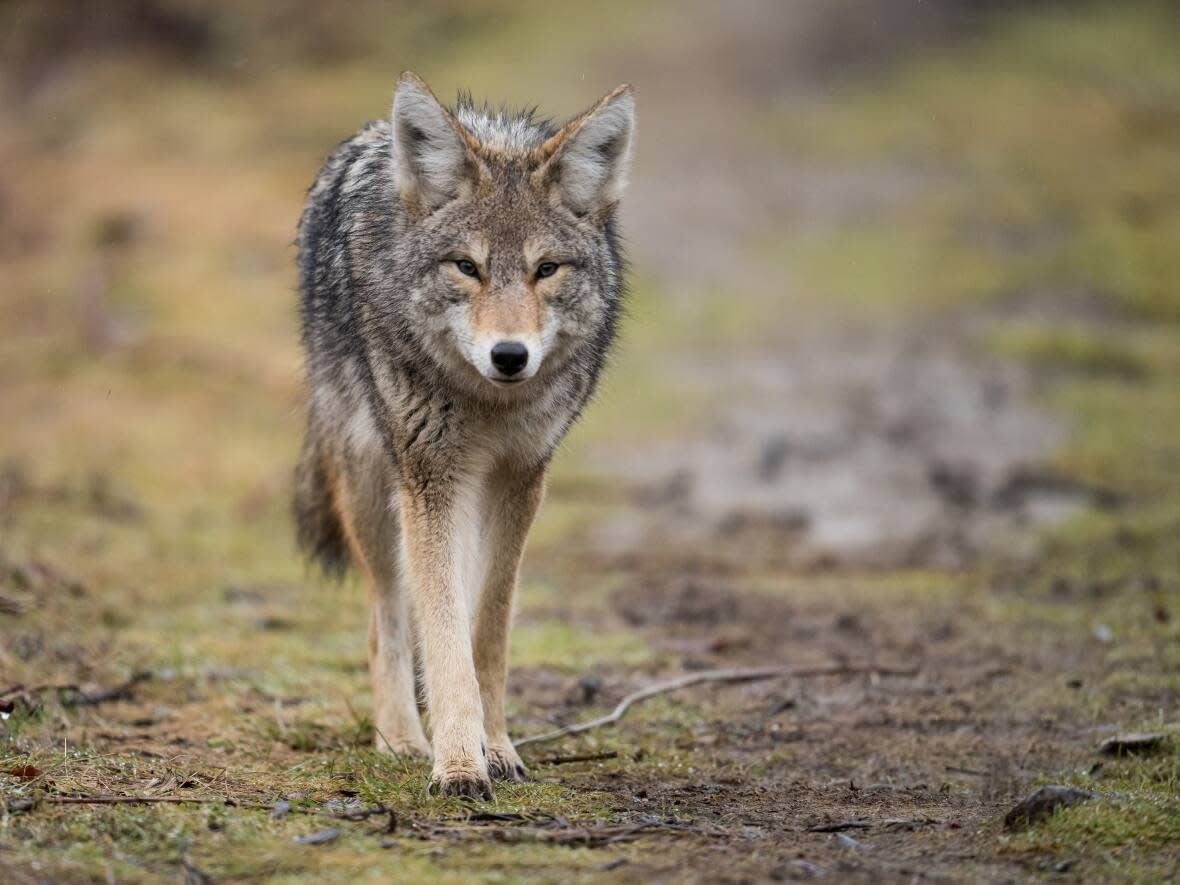Sask. residents cautioned about urban coyotes after sightings in Saskatoon, Moose Jaw

Rebecca Basset was walking her dogs along a popular gravel trail in Saskatoon when she came across a coyote.
The Saskatoon woman said there are often distant sightings of the animals in the Crocus Prairie area, near the Northeast Swale, around dawn and dusk. But this one was different.
"The coyote had come out of the bushes and approached the gravel trail," said Basset, who spotted the coyote on March 17.
The animal approached "boldly, but not aggressively — not with a threat, but almost a sense of curiosity and playfulness," she said.
Coyotes are known to be deterred by loud noises, but Basset said the one she saw wasn't initially moved by her yelling. However, it did eventually distance itself.
"I actually think I encountered normal coyote behaviour in the sense that they've become habituated and familiarized with people," she said. "We're just more and more in their natural space."
Coyotes 'acting strangely': Saskatoon police
On Monday, Saskatoon police posted an advisory cautioning the public about coyotes while outdoors.
A day after Basset's sighting, officers responded to reports of three coyotes people had spotted in distress and "acting strangely."
The first was found lying in an alley in the 600 block of Feheregyhazi Boulevard, near the Northeast Swale, on March 18. The second was spotted later that day at the Sutherland dog park, near Fedoruk Drive and Central Avenue.
Both animals were deemed to be in distress and " behaving abnormally," and were euthanized, police said. They did not say how the animals were killed.
While responding to the second call, police said an officer was approached by someone reporting another coyote acting strangely in the dog park.
The third animal was confirmed to be in distress, but ran away before it could be euthanized, police said.
[Coyotes] have a job to do and they do it well. For the most part, it's nice if we can just get along with our wildlife. - Daily Lennox, City of Moose Jaw parks supervisor
CBC asked the Ministry of Environment Friday about the sick animals. In an email response, the government stated the two euthanized coyotes were delivered to the Canadian Wildlife Health Cooperative for a necropsy (an animal autopsy).
"The cause of their illness has not yet been determined," the ministry wrote.
Daily Lennox, parks supervisor for the City of Moose Jaw, told CBC News there have been two reports of coyote sightings in that southwestern Saskatchewan city recently.
Lennox said the city works with the provincial conservation department if an animal needs to be relocated. If one is found to be sick, it is often euthanized to avoid spreading illness and to stop any suffering, said Lennox.
Residents are urged not to touch sick animals, and to call or file an online report with the city when a coyote is spotted.
Important to ecosystem: parks supervisor
In an average year, Lennox said she receives five or six coyote reports each spring, with some sightings throughout summer.
"They are on the outskirts of the city or on the edges, or on larger green spaces inside the city," Lennox said.
"If you live in a development that's near an open field, chances are you're going to have coyotes there."
The animals might be inclined to follow people from a distance if they are protecting their dens, Lennox said. However, the mostly nocturnal animals keep to themselves.
At this point in the year, "coyotes are starting to have their dens and have their babies. They're a little more visible now," she said.
Attacks on people are very rare, and are usually prompted by a coyote protecting its den and pups when they do happen, said Lennox.
"We have never had an incident of a coyote attacking a dog anywhere in this town that I've heard of … and they don't like being around people."
However, domestic pets could fall victim. The City of Moose Jaw advises residents to:
Avoid leaving food out in your yard.
Refrain from feeding wildlife.
Check on small pets often when left outside, and don't let cats roam.
Clean up dog feces, fallen fruit, garbage and other food sources, like fallen bird seed.
Lennox was quick to point out animals like coyotes and foxes play an important role in their ecosystems, keeping rodent populations — particularly gophers and mice — under control.
"They have a job to do and they do it well," she said. "For the most part, it's nice if we can just get along with our wildlife."
On its website, Wascana Centre in Regina notes coyotes have existed in the natural prairie ecosystem "for decades without issue."
It advises people who find themselves in close proximity to a coyote not to run, and instead raise their hands above their heads, yell and clap to scare it.


